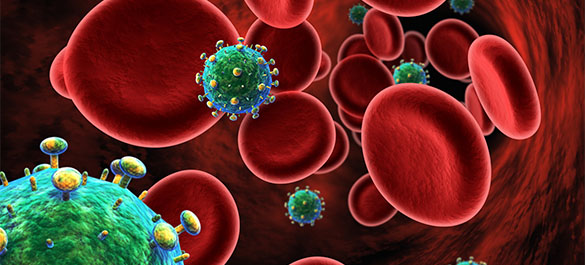
การจัดการภาวะแทรกซ้อนยาต้านรีโทรไวรัส ตอน 4
- โดย ภก.วิชญ์ภัทร ธรานนท์
- 4 กันยายน 2561
- Tweet

ผู้ป่วยติดเชื้อเอชไอวีจะได้รับประโยชน์จากยาต้านรีโทรไวรัสเพื่อกดปริมาณเชื้อไวรัสเอชไอวีและทำให้ภูมิคุ้มกันร่างกายฟื้นตัวได้ดียิ่งขึ้น โดยปัจจุบันการเริ่มใช้ยาต้านรีโทรไวรัสถูกแนะนำให้เริ่มทุกระดับ CD4 จึงทำให้ผู้ป่วยมีโอกาสได้รับยาต้านรีโทรไวรัสเร็วขึ้นกว่าในอดีต อย่างไรก็ตาม มีการรายงานผลอาการไม่พึงประสงค์จากการใช้ยาต้านรีโทรไวรัสทั้งระยะสั้นและระยะยาว หากแพทย์ และเภสัชกรทราบปัจจัยดังต่อไปนี้ที่มีผลชักนำให้เกิดอาการไม่พึงประสงค์จากการใช้ยาต้านรีโทรไวรัสในผู้ป่วย จะช่วยเพิ่มความตระหนักในการดูแล ติดตาม และป้องกันการเกิดอาการไม่พึงประสงค์จากยาทั้งในระยะสั้นและระยะยาวที่มีสาเหตุจากยาต้านรีโทรไวรัสได้ รวมถึงช่วยประคับประคองการรักษาให้เกิดผลลัพธ์ที่ดีตลอดช่วงชีวิตของผู้ป่วย จากการศึกษาที่ผ่านมาในอดีตได้รวบรวมและวิเคราะห์ปัจจัยที่มีผลชักนำต่อการเกิดอาการไม่พึงประสงค์ ดังจะกล่าวต่อจากนี้
1. การใช้ยาที่ส่งผลอาการไม่พึงประสงค์ชนิดเดียวกัน/มีอาการไม่พึงประสงค์จากยาในรูปแบบเดียวกัน (overlapping and additive toxicities) ร่วมกันมากกว่าหนึ่งชนิด เช่น ผู้ป่วยที่ได้รับยา trimethoprim/sulfamethoxazole หรือ ยาแบคทริม (Bactrim) เพื่อป้องกันหรือรักษาภาวะปอดอักเสบจากเชื้อพีซีพี (Pneumcystis jirovecii) ร่วมกับยาต้านเนวิราปีน (nevirapine) ที่ใช้รักษาเอชไอวี ซึ่งมีรายงานการเกิดผื่นจากยาทั้งสองชนิดนี้ได้บ่อย ดังนั้น หากเริ่มยาทั้งสองพร้อมๆกันทันทีในช่วงเวลาเดียวกัน อาจมีผลทำให้เกิดผื่นตามร่างกายได้มากกว่าการใช้ยาชนิดใดชนิดหนึ่งตัวเดียว และยิ่งเพิ่มความลำบากในการวินิจฉัยสาเหตุของผื่นว่าเกิดขึ้นจากยาตัวใด ดังนั้นจึงควรหลีกเลี่ยงการใช้ยาที่มีผลอาการไม่พึงประสงค์ชนิดเดียวกันพร้อมกัน หรือให้คู่กันในช่วงแรกของการเริ่มใช้ยา
2. โรคร่วม หรือภาวะโรคที่ผู้ป่วยกำลังประสบอยู่อาจมีผลเพิ่มความเสี่ยงในการเกิดอาการไม่พึงประสงค์ที่มีสาเหตุจากยา เช่น ภาวะติดสุรา (alcoholism) การติดเชื้อไวรัสตับอักเสบทั้งชนิดซี และชนิดบี ซึ่งอาจมีผลเพิ่มความเสี่ยงในการเกิดภาวะพิษต่อตับ ภาวะโรคทางจิตเวชเดิมของผู้ป่วยอาจกำเริบเมื่อใช้ยาต้านรีโทรไวรัสเอฟฟาไวเร็นซ์ (efavirenz) ริวพิไวรีน(rilpivirine) และยา กลุ่ม integrase strand transfer inhibitors (INSTIs) และภาวะไตบกพร่องอาจเพิ่มความเสี่ยงในการเกิดภาวะพิษต่อไตเมื่อได้รับยาทีโนโฟเวียร์ (tenofovir disoproxil fumarate; TDF)
3. การเกิดปฏิกิริยาระหว่างยา (drug-drug interactions) ที่มีผลกระทบต่อระดับยาที่ผู้ป่วยได้รับ ทั้งระดับยาต้านรีโทรไวรัสที่สูงกว่าปกตินำมาซึ่งผลพิษจากยา หรือระดับยาชนิดอื่นๆที่ได้รับร่วม
ยาต้านรีโทรไวรัสหลายชนิด โดยเฉพาะกลุ่มเอ็นเอ็นอาร์ทีไอ (NNRTIs) และโปรติเอส อินฮิบิเตอร์ (Protease inhibitors (PIs)) จะถูกเมทาบอไลซ์หรือทำลายยาที่ตับผ่านเอ็นไซม์ซิพ(cytochrome P450; CYP450) โดยเฉพาะ CYP3A4 isozyme ดังนั้นจะมีปฏิกิริยาระหว่างยากับยาหลายชนิด การสั่งยาต้านไวรัสให้กับผู้ติดเชื้อเอชไอวีจึงต้องมีความระมัดระวัง เพราะ เมื่อเกิดปฏิกิริยาระหว่างยาแล้ว ในบางครั้งอาจจะทำให้เกิดอาการรุนแรงมากจนถึงเสียชีวิตได้ และในทางตรงข้ามยาบางชนิดอาจทำให้ระดับยาต้านรีโทรไวรัสลดลง ส่งผลให้เกิดการรักษาล้มเหลวได้ นอกจากนี้ควรจะให้คำแนะนำผู้ป่วยด้วยว่า ยาชนิดใดควรจะใช้ด้วยความระมัดระวัง ยาชนิดใดไม่ควรใช้ด้วยกัน หรือถ้าไม่แน่ใจควรปรึกษาแพทย์ เภสัชกร หรือผู้ที่ดูแลรักษาก่อนจะใช้ยาอื่นๆ และก่อนที่จะมีการสั่งยาใหม่ชนิดใดๆ ก็ตามให้กับผู้ติดเชื้อเอชไอวีควรมีการตรวจสอบปฏิกิริยาระหว่างยาก่อนเสมอ
ปฏิกิริยาระหว่างยา ที่เกิดขึ้นนั้นมีโอกาสเป็นไปได้จากปฏิกิริยาระหว่างยาต้านรีโทรไวรัสด้วยกันเอง และระหว่างยาต้านรีโทรไวรัสกับยาประเภทอื่นที่ผู้ป่วยใช้อยู่ ยาต้านรีโทรไวรัสกลุ่ม โปรติเอส อินฮิบิเตอร์ (หรือ PIs) ทั้งกลุ่มจะถูกทำลายโดย CYP450 และบางชนิดจะผ่านทาง p-glycoprotein ด้วย ส่วนยากลุ่มเอ็นอาร์ทีไอ (NRTIs) จะไม่ผ่าน CYP450 ที่ตับ แต่ก็มีรายงานปฏิกิริยาระหว่างยา เช่น ระดับยาดีดาโนซีน (ddI) สูงขึ้นและเกิดผลข้างเคียงมากขึ้นเมื่อให้ยานี้ร่วมกับไฮดรอกซียูเรีย (hydroxyurea) ไรยาวาริน (ribavirin) หรือ ทีโนโฟเวียร์ (TDF)
3.1 รูปแบบการเกิดปฏิกิริยาระหว่างยาโดยขบวนการขจัดยาออกจากร่างกาย (metabolism) แบ่งได้ 3 รูปแบบ คือ
3.1.1 การใช้ยาต้านรีโทรไวรัสร่วมกับยาที่สามารถกระตุ้นการทำงานเอนไซม์ cytochrome P450 (CYP inducer) ทำให้ระดับของยาอีกชนิดที่ต้องถูกขจัดที่ตับโดยเอนไซม์ CYP450 มากขึ้น เช่น ไรแฟมปิซิน (rifampicin) เป็น ซิพ อินดิวเซอร์ (CYP inducer) สามารถลดระดับยากลุ่มเอ็นเอ็นอาร์ทีไอ (NNRTIs) และ กลุ่มโปรติเอส อินฮิบิเตอร์ (PIs) ทุกชนิดได้ ทำให้มีโอกาสเกิดการรักษาล้มเหลวได้ แต่ยาไรแฟมปิซิน จะมีผลต่อยาเอฟฟาไวเร็นซ์น้อยที่สุด ดังนั้นควรเลือกใช้เป็นยาชนิดแรก หากต้องใช้ยากลุ่มเอ็นเอ็นอาร์ทีไอร่วมกัน ส่วนยากลุ่ม PIs ยังไม่แนะนำให้ใช้ร่วม
3.1.2 การใช้ยาต้านรีโทรไวรัสร่วมกับยาที่สามารถยับยั้งการทำงานเอนไซม์ cytochrome P450 (CYP inhibitor) ทำให้ระดับของยาอีกชนิดที่ใช้ร่วมกันที่ถูกขจัดยาที่ตับโดย CYP450 มีระดับสูงขึ้น เช่น ริโทนาเวียร์ (ritonavir) เป็น ซิพ อินฮิบิเตอร์ (CYP inhibitor) ทำให้ระดับยากลุ่มโปรติเอส อินฮิบิเตอร์ (PIs) ชนิดอื่นสูงขึ้น จึงได้ใช้ประโยชน์ทางเภสัชวิทยานี้มาใช้ในทางคลินิก คือ การใช้เพิ่มระดับยากลุ่ม PIs เมื่อให้ร่วมกันหรือที่เรียกว่า boosted PIs
3.1.3 การใช้ยาต้านรีโทรไวรัสที่มีส่วนประกอบของยาที่เป็นได้ทั้ง CYP inducer และ CYP inhibitor เช่น เนวิราปีน (Nevirapine) เป็นได้ทั้งสารตั้งต้น (substrate) ของ CYP450 และยังเป็น CYP inducer ได้ด้วย
บรรณานุกรม:
- Department of disease control, Thailand National Guidelines on HIV/AIDS Treatment and Prevention 2017. availavle from http://www.thaiaidssociety.org/images/PDF/ hiv_thai_guideline _2560.pdf.
- Cohen DE, Mayer KH. Primary care issues for HIV-infected patients. Infect Dis Clin N Am 21 (2007): 49–70.
- วีรวัฒน์ มโนสุทธิ. Current management of complication of antiretroviral therapy. ใน: ชาญกิจ พุฒิเลอพงศ์, ณัฏฐดา อารีเปี่ยม, แสง อุษยาพร, บรรณาธิการ. Pharmacotherapy in infectious disease VII. กรุงเทพมหานคร. สำนักพิมพ์แห่งจุฬาลงกรณ์มหาวิทยาลัย. 2558, หน้า 198-201.
- Group TISS. Initiation of Antiretroviral Therapy in Early Asymptomatic HIV Infection. New England Journal of Medicine. 2015;373(9):795-807.
- Group TTAS. A Trial of Early Antiretrovirals and Isoniazid Preventive Therapy in Africa. New England Journal of Medicine. 2015;373(9):808-22.
- Ayoko R. Bossou SC, Karen K. O’Brien, Catherine A. Opere, Christopher J. Destache. Preventive HIV Vaccines: Progress and Challenges. US Pharmacist. 2015 OCTOBER 16, 2015:46-50.
- รัชนู เจริญพักตร์ และ ชาญกิจ พุฒิเลอพงศ์. Current update on HIV/AIDs treatment guideline in 2017. ใน: ชาญกิจ พุฒิเลอพงศ์, โชติรัตน์ นครานุรักษ์, และ แสง อุษยาพร, บรรณาธิการ. Pharmacotherapy in infectious disease IX. กรุงเทพมหานคร. สำนักพิมพ์แห่งจุฬาลงกรณ์มหาวิทยาลัย. 2560, หน้า 342-364.
- Wada N JL, Cohen M, French A, Phair J, Munoz A. Cause-specific life expectancies after 35 years of age for human immunodeficiency syndrome-infected and human immunodeficiency syndrome-negative individuals followed simultaneously in long-term cohort studies, 1984-2008. Am J Epidermol. 2013; 177: 116-125.
- Department of Health and Human Services. Guidelines for the Use of Antiretroviral Agents in Adults and Adolescents Living with HIV Available from: https://aidsinfo.nih.gov/guidelines.
- O'Brien ME, Clark RA, Besch CL, Myers L, Kissinger P. Patterns and correlates of discontinuation of the initial HAART regimen in an urban outpatient cohort. Journal of acquired immune deficiency syndromes (1999). 2003;34(4):407-14.
- Kiertiburanakul S, Luengroongroj P, Sungkanuparph S. Clinical characteristics of HIV-infected patients who survive after the diagnosis of HIV infection for more than 10 years in a resource-limited setting. Journal of the International Association of Physicians in AIDS Care (Chicago, Ill : 2002). 2012;11(6):361-5.
- Wiboonchutikul S, Sungkanuparph S, Kiertiburanakul S, Chailurkit LO, Charoenyingwattana A, Wangsomboonsiri W, et al. Vitamin D insufficiency and deficiency among HIV-1-infected patients in a tropical setting. Journal of the International Association of Physicians in AIDS Care (Chicago, Ill : 2002). 2012;11(5):305-10.
- Wilde JT, Lee CA, Collins P, Giangrande PL, Winter M, Shiach CR. Increased bleeding associated with protease inhibitor therapy in HIV-positive patients with bleeding disorders. British journal of haematology. 1999;107(3):556-9.
- European AIDS Clinical Society. EACS Guidelines version 8.1-October 2016. Available from http://www.eacsociety.org/files/guidelines_8.1-english.pdf.
- ศศิโสภิณ เกียรติบูรณกุล. การดูแลรักษาผู้ติดเชื้อเอชไอวีแบบผู้ป่วยนอก.กรุงเทพฯ : ภาควิชาอายุรศาสตร์ คณะแพทยศาตร์โรงพยาบาลรามาธิบดี มหาวิทยาลัยมหิดล, 2557
- Morse CG, Mican JM, Jones EC, Joe GO, Rick ME, Formentini E, et al. The incidence and natural history of osteonecrosis in HIV-infected adults. Clinical infectious diseases : an official publication of the Infectious Diseases Society of America. 2007;44(5):739-48.
- Woodward CL, Hall AM, Williams IG, Madge S, Copas A, Nair D, et al. Tenofovir-associated renal and bone toxicity. HIV medicine. 2009;10(8):482-7.
- Wang H, Lu X, Yang X, Xu N. The efficacy and safety of tenofovir alafenamide versus tenofovir disoproxil fumarate in antiretroviral regimens for HIV-1 therapy: Meta-analysis. Medicine. 2016;95(41):e5146.
- Redig AJ, Berliner N. Pathogenesis and clinical implications of HIV-related anemia in 2013. Hematology American Society of Hematology Education Program. 2013;2013:377-81.
- Assefa M, Abegaz WE, Shewamare A, Medhin G, Belay M. Prevalence and correlates of anemia among HIV infected patients on highly active anti-retroviral therapy at Zewditu Memorial Hospital, Ethiopia. BMC Hematology. 2015;15:6.
- de Gaetano Donati K, Cauda R, Iacoviello L. HIV Infection, Antiretroviral Therapy and Cardiovascular Risk. Mediterranean Journal of Hematology and Infectious Diseases. 2010;2(3):e2010034.
- Group TDS. Class of Antiretroviral Drugs and the Risk of Myocardial Infarction. New England Journal of Medicine. 2007;356(17):1723-35.
- Tsiodras S, Mantzoros C, Hammer S, Samore M. Effects of protease inhibitors on hyperglycemia, hyperlipidemia, and lipodystrophy: a 5-year cohort study. Archives of internal medicine. 2000;160(13):2050-6.
- วราภณ วงศ์ถาวราวัฒน์. Diagnosis and classification of Diabetes Mellitus. ใน: ธิติ สนับบุญ, บรรณาธิการ. แนวทางเวชปฏิบัติทางต่อมไร้ท่อ. กรุงเทพมหานคร.โรงพิมพ์แห่งจุฬาลงกรณ์มหาวิทยาลัย. 2560, หน้า 1-9.
- ชาญกิจ พุฒิเลอพงศ์. Clinical management for dyslipidemia in HIV-infected patients. ใน: ชาญกิจ พุฒิเลอพงศ์ และ ณัฏฐดา อารีเปี่ยม, บรรณาธิการ. Pharmacotherapy in infectious disease VI. กรุงเทพมหานคร. คอนเซ็พท์พริ้นท์. 2557, หน้า 198-201.
- Dube MP, Stein JH, Aberg JA, Fichtenbaum CJ, Gerber JG, Tashima KT, et al. Guidelines for the evaluation and management of dyslipidemia in human immunodeficiency virus (HIV)-infected adults receiving antiretroviral therapy: recommendations of the HIV Medical Association of the Infectious Disease Society of America and the Adult AIDS Clinical Trials Group. Clinical infectious diseases : an official publication of the Infectious Diseases Society of America. 2003;37(5):613-27.
- Hoffman RM, Currier JS. Management of antiretroviral treatment-related complications. Infectious disease clinics of North America. 2007;21(1):103-32, ix.
- Husain NEOS, Ahmed MH. Managing dyslipidemia in HIV/AIDS patients: challenges and solutions. HIV/AIDS (Auckland, NZ). 2015;7:1-10.
- Kiertiburanakul S, Sungkanuparph S, Charoenyingwattana A, Mahasirimongkol S, Sura T, Chantratita W. Risk factors for nevirapine-associated rash among HIV-infected patients with low CD4 cell counts in resource-limited settings. Current HIV research. 2008;6(1):65-9.
- Murphy RL. Defining the toxicity profile of nevirapine and other antiretroviral drugs. Journal of acquired immune deficiency syndromes (1999). 2003;34 Suppl 1:S15-20.
- Department of Health and Human Services. HIV and Lactic Acidosis. Available from: https://aidsinfo.nih.gov/understanding-hiv-aids/fact-sheets/22/68/hiv-and-lactic-acidosis.
- Grinspoon S, Carr A. Cardiovascular Risk and Body-Fat Abnormalities in HIV-Infected Adults. New England Journal of Medicine. 2005;352(1):48-62.
- Simpson D, Estanislao L, Evans S , McArthur J, Marcusd K, Truffa M et,al. HIV-associated neuromuscular weakness syndrome. AIDS (London, England). 2004;18(10):1403-12.
- Hall AM, Hendry BM, Nitsch D, Connolly JO. Tenofovir-associated kidney toxicity in HIV-infected patients: a review of the evidence. American journal of kidney diseases : the official journal of the National Kidney Foundation. 2011;57(5):773-80.
- Chaisiri K, Bowonwatanuwong C, Kasettratat N, Kiertiburanakul S. Incidence and risk factors for tenofovir-associated renal function decline among Thai HIV-infected patients with low-body weight. Current HIV research. 2010;8(7):504-9.
- Schwarzwald H, Gillespie S. Management of Antiretroviral-Associated Complications. Available from: https://bipai.org/sites/bipai/files/5-Mgt-assoc-complications.pdf
- ศศิโสภิณ เกียรติบูรณกุล. Practical management of complication-associated with ARVใน: นารัต เกษตรทัต, ชาญกิจ พุฒิเลอพงศ์ และ ณัฏฐดา อารีเปี่ยม, บรรณาธิการ. Pharmacotherapy in infectious disease VI. กรุงเทพมหานคร. คอนเซ็พท์พริ้นท์. 2554, หน้า 317-346.


